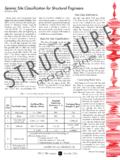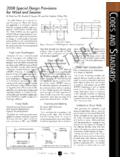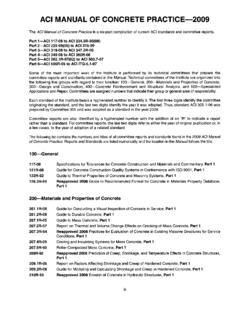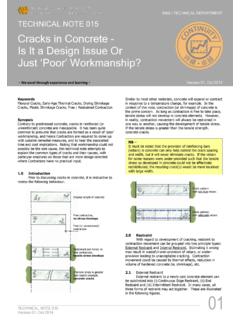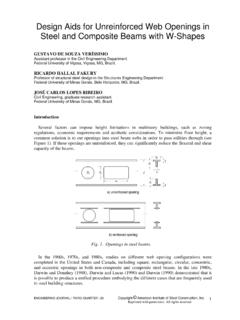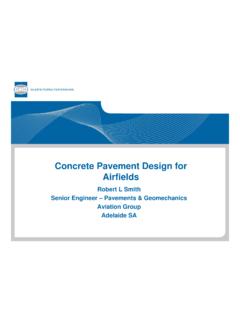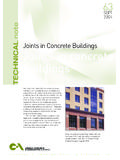Transcription of Example - STRUCTURE magazine
1 STRUCTURE magazineApril 2008discussions on design issues for structural engineersStructural DeSign18 Load-Carrying CapacityConcrete Slabs-On-Grade Subject To Concentrated LoadsBy Victor D. Azzi, , , and Ralph H. LairdThe scope of this article is limited to the design of industrial concrete floor slabs on grade for concentrated loads caused by the columns of free-standing work platforms, mezzanines, or mechanical support structures. The concrete floor slab is presumed to be unreinforced. The STRUCTURE supported by the floor slab is considered to be independent of the building structural system and, therefore, is outside the scope of ACI 318. Further, the spacing of the structural columns supporting these structural platforms is presumed to be sufficiently large, thereby precluding any interactive effects of neighboring evolution of SOG design and behavior has allowed both designers and building officials to have a better understanding of, and confidence in, the load-carrying capacities of SOG subjected to large concentrated column loads.
2 These methods are applicable particularly to industrial warehouses and distribution centers where free-standing steel work platforms or mezzanines, typically carrying storage and equipment loads on upper levels, cause large concentrated forces to act at discrete locations on the warehouse floor on which the work platforms have been installed. The work of Shentu and his colleagues, through a comparison of their analytical predictions and test results, has demon-strated that the load-carrying capacity, as well as settlement behavior, can be well predicted with good results. On that basis, Shentu proceeded to develop a Simplified Analytical Method that is the basis for this article. With this method, and the resulting equations presented in that paper, the determina-tion of the load-carrying capacity of a SOG is found to be simple, practical, and reliable. Extensive investigations conducted by, and on behalf of, the Storage Equipment Manufacturers Association (SMA) have, for several years, been directed to develop an acceptable and reliable design method for floor slabs on grade.
3 This article is intended to summarize their findings. Included here is a brief description of the design parameters for subgrade properties, concrete tensile properties, and the concept of the radius of relative stiffness and its relevance to this problem. Also included is a representative design table, summarizing recommendations resulting from this work for an Example six-inch slab. Employing an Elastoplastic ModelIn earlier years, the determination of the allowable concentrated load applied to an existing concrete floor slab system was solved according to the linear elastic theory of Westergaard. The elastic theory is cor-rect as long as the load is small. However, when the ultimate load-carrying capacity is required, the elastoplastic behavior of con-crete should be taken into account. The more recent research by Shentu and Al-Nasra indicate that there is a substantial difference in the results produced by the methods presented in ACI when compared with those from an elastoplastic analysis.
4 Floor slabs on grade can carry significant additional load after the onset of initial cracking, and it is necessary to take advantage of this additional load-carrying capacity in design procedures for engineering inconsistency in designing exclusively in the elastic range is apparent. Most engineering publications acknowledge the existence of shrinkage cracks in concrete floors. To use a design procedure, based on the analytical model of a floor presumed to be uncracked, for a floor slab known to be cracked, is inappropriate. The long-standing use of design methods that presume a crack-free slab, while simplifying the analytical model, has encouraged the use of methods that produce results that may not be applicable for the design of a realistic floor slab-on-grade. The design table presented later in this article is based on research results employing an elastoplastic model of concrete structural behavior.
5 AnalysisThe design of a floor slab-on-grade in-volves the interaction of a concrete slab and a soil support system. The concrete is a material considered to be heteroge-neous and statistically isotropic, becom-ing orthotropic with the development of micro-cracks. concrete strength in compression is significantly greater than its strength in tension. Micro-cracks may form in the concrete even before load-ing. The soil system, in general, is also heterogeneous; its characteristics and mechanical properties may vary within a wide addition to the concrete slab thickness, the following two properties are critical to the design of a floor slab-on-grade: subgrade strength and concrete tensile generations, structural engineers, and those who review their work, have been concerned that there was a lack of understanding of how concrete slabs-on-grade (SOG) behave, particularly under the effects of discrete concentrated loads.
6 This has led to results that in many cases have been unrealistic and overly conservative in their application. With insufficient information, some have speculated about concrete slab-on-grade behavior, including the surmising of failures such as punching shear, and its dire consequences in applications where none have been observed. Earlier work done by Westergaard, and Ringo and Anderson, have long been the standard of practice. Standards by the ACI also addressed the design of slabs on grade, and Face and Al-Nasra developed a finite-element basis for the design of SOG. More recently, a definitive research paper by Shentu, Jiang, and Hsu has brought about some rigorous focus to the problem, and their analytical and confirming testing results have allowed a better understanding of the behavior and design of SOG. And even more recently, Higgins has introduced the Shentu method as an approach to a practical design method for slabs-on-grade.
7 The significance of this work is further demonstrated by the City of Los Angeles issuing an Information Bulletin stating that this approach, among others, is an Acceptable Design and Analysis Method for Use of Slabs-on-Grade as Foundation. The approach developed here is further cited as an acceptable design and analysis method in a recent Guidance Document, FEMA 460, by the Building Seismic Safety Council of the Federal Emergency Management Agency, which is focused on issues related to seismic behavior of industrial steel storage T R U C T U R E magazineCopyrightS T R U C T U R E magazineCopyrightSTRUCTURE magazineApril 200819 Soil-bearing capacity, soil compressibility, and modulus of subgrade reaction are properties of the soil system that require understanding. Soil-bearing capacity is a measure of soil shear failure. This value is determined by using various standardized soil tests.
8 Soil compressibility is a measure of long-term settlement in a soil under load. This value is normally determined using soil consolidation tests. Modulus of subgrade reaction is the propor-tionality constant, ks, in a Winkler subgrade. Its value depends upon the kind of soil, the degree of compaction, and the moisture con-tent. The modulus of subgrade reaction has units of pci; it is the pressure in psi per inch of soil deformation. The procedure for deter-mining ks is outlined in ASTM D 1196. For the general relationship between the soil classifications and the modulus of subgrade reaction, see their depiction in Figure of ACI R-92. Essentially, soils that have high compressibility and low subgrade strength will have a design ks value of about 50 pci. Natural soils of higher subgrade strength have a design ks value of about 200 pci. The tensile strength of concrete is usually determined by using the split cylinder test in accordance with ASTM C 496.
9 The tensile strength is a more variable property than the compressive strength; it is about 10 to 15 percent of the compressive strength. The tensile strength is between 6(fc ) and 7(fc ) for normal stone concrete . The tensile strength in flexure is the modulus of rupture (ASTM C 78). The modulus of rupture is generally accepted as (fc ) for normal concrete . The magnitude of the compressive strength for concrete is generally available for use by the design engineer. The values presented in Table 1 are for unre-inforced concrete slabs of six-inch thickness. The tabulated values represent the results for the determination of the allowable load- carrying capacities, Pa, for various concrete slabs on grade for a variety of parametric values, based on the application of the following relationship developed by Shentu: Pn = [(ksR1/Ec)104 + ] ft d2(Equation 1) andPa = Pn / FS(Equation 1a)or, alternatively, solving for the thickness, d, and introducing a Factor of Safety (FS) yields: d = [(FSxPa)/( [(ksR1/Ec)104+ ] ft )] (Equation 2)wherePn = nominal load-carrying capacity of the slab on grade, in = allowable load-carrying capacity of the slab on grade, in = modulus of subgrade reaction, in = one-half the width or diameter of the column base plate, in = modulus of elasticity of concrete , in = tensile strength in flexure of concrete , in = slab thickness, in = factor of safety, here taken as = load reduction factor, for d < inches.
10 For d the analysis on which this article is based, tables were developed for slab thicknesses from four to eight inches; however, the loads for the seven-inch and eight-inch thick floor slabs were reduced by fifteen percent, using a load-reduction factor, , to compensate for apparent deviation of the results of Equation 1 from the finite-element results presented in the Shentu earlier work of Packard (12), Pickett and Ray (13) and, more recently, by Spears and Panarese (14), and further detailed in ACI 360R-92 (4), treated the area of influence of a single concentrated load. The slab analyzed has a radius of three times the radius of relative stiffness. The radius of relative stiffness, b, is expressed as the fourth root of the result found by dividing the concrete plate stiffness by the modulus of subgrade reaction as follows:b = [Ecd3/(12 (1 2) ks)] (Equation 3)whereb = radius of relative stiffness, in = modulus of elasticity of concrete , taken here as 4,000,000 = slab thickness, in inches.

